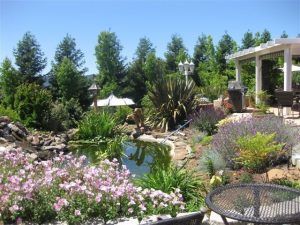It’s the time of year when we review this year’s progress and set priorities for next year. The same is true in the garden. Our commitment to our priorities affects our gardening practices as well as how we use and manage our outside space.
Instead of focusing only on the beauty of flowers, how many plants have died, or the number of irrigation systems still needed, we can ask ourselves the following questions. Can we allocate more space and resources, such as water, to efficiently produce edibles? Do we have adequate food, water and habitat to attract bees, butterflies and bats? Are we using all of our resources, recycling and retaining as much as possible (water, runoff, leaves, llama manure, etc) on the property? What else can we do to reduce fossil fuel use, emissions, pesticides, and our “carbon footprint?”
The choices we make move us in a particular direction. Let’s try to be better stewards of the air and water and land, and their inhabitants—particularly those affected by our actions, such as birds, beneficial bugs and frogs.
Some garden management priorities have a big impact on our environment. We can investigate installing solar panels. We can eliminate chemically based pesticides, herbicides and fertilizers. Applying three to four inches of mulch and grouping plants with similar water needs together will make more effective use of our precious water resources.
Last summer was a particularly difficult gardening season. Maybe a resolution for the coming year could include buying more produce locally from farmers’ markets, especially fruits that don’t do well in our high-temperature environments, such as berries. They can be frozen so that you can enjoy local, organically grown berries all year round.
To enrich the soil and prevent weeds and erosion, we can try covering fallow soil with composted manure, or a cover crop such as alfalfa, buckwheat or annual ryegrass. We can compost and create our own amendments. There are many sources of manure in the foothills – llama, goat, chicken and horse. Develop a relationship with a close-by farm or ranch, if you don’t have a ready source of manure. Red wigglers are worms that can be kept in their own box to create rich compost by recycling paper, kitchen wastes and yard debris (such as leaves).
Another area where we may wish to focus our attention is on reducing gas-powered equipment and electricity use. Outside lights can be controlled by timers or motion detectors; fountains and water features can utilize solar-powered pumps. Eliminating more turfgrass reduces the amount of fuel needed for lawn mowers, edgers and leaf blowers.
A continuing issue is water management. For the vegetable garden, a water collection system that stores winter rains for later use is a high priority. Any new garden areas can be devoted to natives not needing supplemental summer water, once established.
So, although progress is being made, more can always be done. The results are worth it. Not only do we contribute to the health of the planet but also, we become more self-sufficient and ultimately lower our living costs and expenses. These are all powerful motivators to set goals and push ourselves to do more each year.
Marlys Bell is a former University of California Cooperative Extension Master Gardener of Tuolumne County who is also a garden writer and avid gardener.
University of California Cooperative Extension Master Gardeners can answer gardening questions. In Tuolumne County call (209) 533-2912 and in Calaveras County call (209) 754-2880. You can fill out our easy-to-use problem questionnaire here. Check out our website here. You can also find us on Facebook.

